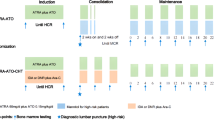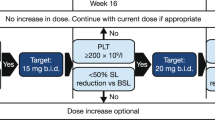Abstract
A multicenter phase II study was initiated to investigate the efficacy, toxicity and tolerability of an oral regimen of 9-cis retinoic acid (9CRA) as a differentiation-inducing agent stimulating both retinoic acid receptor (RAR) and retinoic X receptor (RXR). Thirty patients with myelodysplastic syndromes (MDS) were enrolled into the study. The MDS subtypes were distributed as follows: 14 refractory anaemia (RA), four refractory anaemia with ringed sideroblasts (RARS), and 12 refractory anaemia with excess blasts (RAEB). The age ranged from 40 to 81 years (median 70). None of these had previously received treatment for MDS other than supportive therapy. 9CRA (Alitretinoin capsules, kindly provided by Allergan-Ligand Retinoid Therapeutics) was given daily at 60 mg/m2 p.o. for 1 week, followed by an intra-patient escalation to 100 mg/m2 during the second week, up to a maximum of 140 mg/m2. The planned treatment duration was 48 weeks. Twenty-five were available for assessment. One patient (4%) with RA achieved complete hematological remission. Four (16%), two with RA, two with RAEB, had minor responses resulting in decreased transfusion requirements or increased neutrophils. Thus, the overall response rate was 20% in evaluable patients with MDS and 17% in the study group on an intention-to-treat basis. The most frequent side-effects included headache (77%), dry skin (57%), arthralgias (30%), and rash (23%). In conclusion, although modest responses were noted in this study, the treatment tolerability was suboptimal. It is conceivable that a lower dosage schedule may be efficacious and better tolerated so enabling prolonged exposure which may be required to induce a differentiation effect. Leukemia (2000) 14, 1583–1588.
This is a preview of subscription content, access via your institution
Access options
Subscribe to this journal
Receive 12 print issues and online access
$259.00 per year
only $21.58 per issue
Buy this article
- Purchase on Springer Link
- Instant access to full article PDF
Prices may be subject to local taxes which are calculated during checkout
Similar content being viewed by others
References
Lohnes D, Mark M, Mendelsohn C, Dolle P, Decimo D, LeMeur M, Dierich A, Gorry P, Chambon P . Developmental roles of the retinoic acid receptors J Steroid Biochem Mol Biol 1995 53: 475–486
Morriss-Kay G . Retinoic acid receptors in normal growth and development Cancer Surv 1992 14: 181–193
Muindi JR, Frankel SR, Huselton C, DeGrazia F, Garland WA, Young CW, Warrell RPJ . Clinical pharmacology of oral all-trans retinoic acid in patients with acute promyelocytic leukemia Cancer Res 1992 52: 2138–2142
Ng KW, Zhou H, Manji S, Martin TJ . Regulation and regulatory role of the retinoids Crit Rev Eukaryot Gene Expr 1995 5: 219–253
Stunnenberg HG . Mechanisms of transactivation by retinoic acid receptors Bioessays 1993 15: 309–315
Bollag W . Experimental basis of cancer combination chemotherapy with retinoids, cytokines, 1,25-dihydroxyvitamin D3, and analogs J Cell Biochem 1994 56: 427–435
Petkovich M, Brand NJ, Krust A, Chambon P . A human retinoic acid receptor which belongs to the family of nuclear receptors Nature 1987 330: 444–450
de Thé H, Chomienne C, Lanotte M, Degos L, Dejean A . The t(15;17) translocation of acute promyelocytic leukaemia fuses the retinoic acid receptor alpha gene to a novel transcribed locus Nature 1990 347: 558–561
de Thé H, Lavau C, Marchio A, Chomienne C, Degos L, Dejean A . The PML-RAR alpha fusion mRNA generated by the t(15;17) translocation in acute promyelocytic leukemia encodes a functionally altered RAR Cell 1991 66: 675–684
Mangelsdorf DJ, Ong ES, Dyck JA, Evans RM . Nuclear receptor that identifies a novel retinoic acid response pathway Nature 1990 345: 224–229
Kliewer SA, Umesono K, Mangelsdorf DJ, Evans RM . Retinoid X receptor interacts with nuclear receptors in retinoic acid, thyroid hormone and vitamin D3 signalling Nature 1992 355: 446–449
Parker JE, Mufti GJ . Ineffective haemopoiesis and apoptosis in myelodysplastic syndromes Br J Haematol 1998 101: 220–230
Aul C, Bowen DT, Yoshida Y . Pathogenesis, etiology and epidemiology of myelodysplastic syndromes Haematologica 1998 83: 71–86
Hofmann WK, Ottmann OG, Ganser A, Hoelzer D . Myelodysplastic syndromes: clinical features Semin Hematol 1996 33: 177–185
Seipelt G, Ganser A, Duranceyk H, Maurer A, Ottmann OG, Hoelzer D . Induction of TNF-alpha in patients with myelodysplastic syndromes undergoing treatment with interleukin-3 Br J Haematol 1993 84: 749–751
Yoshida Y, Mufti GJ . Apoptosis and its significance in MDS: controversies revisited Leuk Res 1999 23: 777–785
Shimizu R, Komatsu N, Miura Y . Dominant negative effect of a truncated erythropoietin receptor (EPOR-T) on erythropoietin-induced erythroid differentiation: possible involvement of EPOR-T in ineffective erythropoiesis of myelodysplastic syndrome Exp Hematol 1999 27: 229–233
Hoefsloot LH, van AM, Broeders LC, van der Plas DC, van LK, Hoogerbrugge H, Touw IP, Lowenberg B . Erythropoietin-induced activation of STAT5 is impaired in the myelodysplastic syndrome Blood 1997 89: 1690–1700
Bowen D . What is ineffective erythropoiesis in myelodysplastic syndromes? Leuk Lymphoma 1995 18: 243–247
Hofmann WK, Kalina U, Wagner S, Seipelt G, Ries C, Hoelzer D, Ottmann OG . Characterization of defective megakaryocytic development in patients with myelodysplastic syndromes Exp Hematol 1999 27: 395–400
Sawada K . Impaired proliferation and differentiation of myelodysplastic CD34+ cells Leuk Lymphoma 1994 14: 37–47
Morosetti R, Koeffler HP . Differentiation therapy in myelodysplastic syndromes Semin Hematol 1996 33: 236–245
Ganser A, Seipelt G, Verbeek W, Ottmann OG, Maurer A, Kolbe K, Hess U, Elsner S, Reutzel R, Wormann B . Effect of combination therapy with all-trans retinoic acid and recombinant human granulocyte colony-stimulating factor in patients with myelodysplastic syndromes Leukemia 1994 8: 369–375
Hofmann WK, Ganser A, Seipelt G, Ottmann OG, Zander C, Geissler G, Hoffmann K, Hoffken K, Fischer JT, Isele G, Hoelzer D . Treatment of patients with low-risk myelodysplastic syndromes using a combination of all-trans retinoic acid, interferon alpha, and granulocyte colony-stimulating factor Ann Hematol 1999 78: 125–130
Ferrero D, Bruno B, Pregno P, Stefani S, Larizza E, Ciravegna G, Luraschi A, Vietti-Ramus G, Schinco P, Bazzan M, Gallo E, Pileri A . Combined differentiating therapy for myelodysplastic syndromes: a phase II study Leuk Res 1996 20: 867–876
Hellstrom E, Robert KH, Samuelsson J, Lindemalm C, Grimfors G, Kimby E, Oberg G, Winqvist I, Billstrom R, Carneskog J . Treatment of myelodysplastic syndromes with retinoic acid and 1 alpha-hydroxy-vitamin D3 in combination with low-dose ara-C is not superior to ara-C alone. Results from a randomized study. The Scandinavian Myelodysplasia Group (SMG) Eur J Haematol 1990 45: 255–261
Ganser A, Maurer A, Contzen C, Seipelt G, Ottmann OG, Schadeck-Gressel C, Kolbe K, Haas R, Zander C, Reutzel R, Hoelzer D . Improved multilineage response of hematopoiesis in patients with myelodysplastic syndromes to a combination therapy with all-trans retinoic acid, granulocyte colony-stimulating factor, erythropoietin and alpha-tocopherol Ann Hematol 1996 72: 237–244
Ganser A, Karthaus M . Clinical use of hematopoietic growth factors in the myelodysplastic syndromes Leuk Lymphoma 1997 26: (Suppl. 1.) 13–27
Santini V, Ferrini PR . Differentiation therapy of myelodysplastic syndromes: fact or fiction? Br J Haematol 1998 102: 1124–1138
Heyman RA, Mangelsdorf DJ, Dyck JA, Stein RB, Eichele G, Evans RM, Thaller C . 9-cis retinoic acid is a high affinity ligand for the retinoid X receptor Cell 1992 68: 397–406
Levin AA, Sturzenbecker LJ, Kazmer S, Bosakowski T, Huselton C, Allenby G, Speck J, Kratzeisen C, Rosenberger M, Lovey A . 9-cis retinoic acid stereoisomer binds and activates the nuclear receptor RXR alpha Nature 1992 355: 359–361
Mangelsdorf DJ . Vitamin A receptors Nutr Rev 1994 52: S32–S44
Pemrick SM, Lucas DA, Grippo JF . The retinoid receptors Leukemia 1994 8: 1797–1806
Kizaki M, Ikeda Y, Tanosaki R, Nakajima H, Morikawa M, Sakashita A, Koeffler HP . Effects of novel retinoic acid compound, 9-cis-retinoic acid, on proliferation, differentiation, and expression of retinoic acid receptor-alpha and retinoid X receptor-alpha RNA by HL-60 cells Blood 1993 82: 3592–3599
Sakashita A, Kizaki M, Pakkala S, Schiller G, Tsuruoka N, Tomosaki R, Cameron JF, Dawson MI, Koeffler HP . 9-cis-retinoic acid: effects on normal and leukemic hematopoiesis in vitro Blood 1993 81: 1009–1016
Miller VA, Rigas JR, Benedetti FM, Verret AL, Tong WP, Kris MG, Gill GM, Loewen GR, Truglia JA, Ulm EH, Warrell RP Jr . Initial clinical trial of the retinoid receptor pan agonist 9-cis retinoic acid Clin Cancer Res 1996 2: 471–475
Rizvi NA, Marshall JL, Ness E, Yoe J, Gill GM, Truglia JA, Loewen GR, Jaunakais D, Ulm EH, Hawkins MJ . Phase I study of 9-cis-retinoic acid (ALRT1057 capsules) in adults with advanced cancer Clin Cancer Res 1998 4: 1437–1442
Soignet SL, Benedetti F, Fleischauer A, Parker BA, Truglia JA, Ra Crisp M, Warrell RP Jr . Clinical study of 9-cis retinoic acid (LGD1057) in acute promyelocytic leukemia Leukemia 1998 12: 1518–1521
Bennett JM, Catovsky D, Daniel MT, Flandrin G, Galton DA, Gralnick HR, Sultan C . Proposals for the classification of the myelodysplastic syndromes Br J Haematol 1982 51: 189–199
Greenberg P, Cox C, LeBeau MM, Fenaux P, Morel P, Sanz G, Sanz M, Vallespi T, Hamblin T, Oscier D, Ohyashiki K, Toyama K, Aul C, Mufti G, Bennett J . International scoring system for evaluating prognosis in myelodysplastic syndromes Blood 1997 89: 2079–2088
Koeffler HP, Heitjan D, Mertelsmann R, Kolitz JE, Schulman P, Itri L, Gunter P, Besa E . Randomized study of 13-cis retinoic acid vs placebo in the myelodysplastic disorders Blood 1988 71: 703–708
Besa EC, Abrahm JL, Bartholomew MJ, Hyzinski M, Nowell PC . Treatment with 13-cis-retinoic acid in transfusion-dependent patients with myelodysplastic syndrome and decreased toxicity with addition of alpha-tocopherol Am J Med 1990 89: 739–747
Visani G, Tosi P, Manfroi S, Ottaviani E, Finelli C, Cenacchi A, Bendandi M, Tura S . All-trans retinoic acid in the treatment of myelodysplastic syndromes Leuk Lymphoma 1995 19: 277–280
Aul C, Runde V, Gattermann N . All-trans retinoic acid in patients with myelodysplastic syndromes: results of a pilot study Blood 1993 82: 2967–2974
Hellstrom E, Robert KH, Gahrton G, Mellstedt H, Lindemalm C, Einhorn S, Bjorkholm M, Grimfors G, Uden AM, Samuelsson J . Therapeutic effects of low-dose cytosine arabinoside, alpha-interferon, 1 alpha-hydroxyvitamin D3 and retinoic acid in acute leukemia and myelodysplastic syndromes Eur J Haematol 1988 40: 449–459
Shiohara M, Dawson MI, Hobbs PD, Sawai N, Higuchi T, Koike K, Komiyama A, Koeffler HP . Effects of novel RAR- and RXR-selective retinoids on myeloid leukemic proliferation and differentiation in vitro Blood 1999 93: 2057–2066
Kizaki M, Koeffler HP . Differentiation-inducing agents in the treatment of myelodysplastic syndromes Semin Oncol 1992 19: 95–105
Author information
Authors and Affiliations
Rights and permissions
About this article
Cite this article
Hofmann, W., Kell, W., Fenaux, P. et al. Oral 9-cis retinoic acid (Alitretinoin) in the treatment of myelodysplastic syndromes: results from a pilot study. Leukemia 14, 1583–1588 (2000). https://doi.org/10.1038/sj.leu.2401873
Received:
Accepted:
Published:
Issue Date:
DOI: https://doi.org/10.1038/sj.leu.2401873



